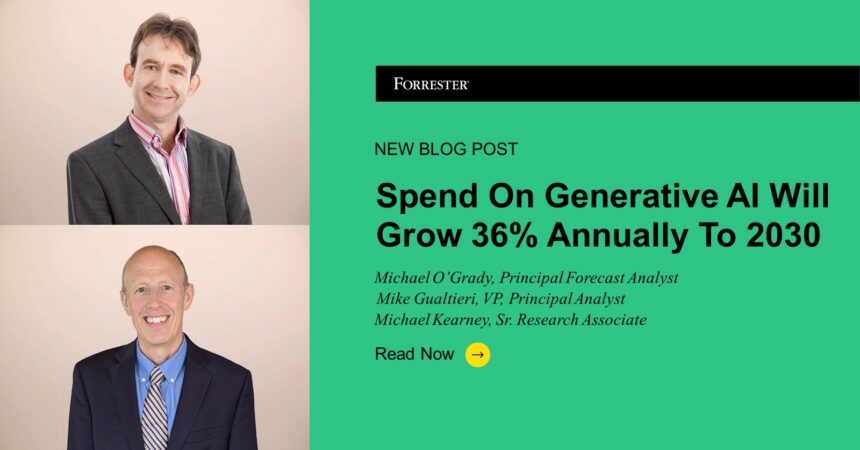Generative AI’s meteoric rise can be compared to the launch of social media, the smartphone, and the internet. The technology’s wide applicability across industries and occupations will drive massive growth: According to Forrester’s new forecast, generative AI will have an average annual growth rate of 36% up to 2030, capturing 55% of the AI software market.
This unprecedented growth will be driven by:
- Specialized adoption. By 2030, $79 billion will be spent annually on specialized applications designed to improve automation and increase productivity, especially in the security, health, and content marketing industries. For example, code assistants such as GitHub Copilot and Replit are making software development more accessible for software professionals and citizen developers alike. Applications can also be used to develop new products. The home healthcare provider Cera is using analytics technology to monitor its users’ health in real time and generative AI to create visual content that explains complex medical concepts in simple ways.
- Generalized adoption. By 2030, $42 billion will be spent annually on generalized use cases, such as research, writing, and summarizing tools. More than 50% of this spend will be on chatbot and communications platforms, which will drive substantial improvements in customer and employee experience. For example, the communications tool company Twilio recently adopted generative AI technology to improve sales and marketing team conversations through a cookieless personalized service that builds out customer profiles from after-call summaries and sentiment analysis. The language learning platform Duolingo also introduced a new “Max” subscription tier that uses GPT-4 for two new chatbots, one that explains a user’s incorrect answers and the other that acts as a roleplay tutor.
- New business revenue. Proliferation of generative AI will open new revenue opportunities even for businesses that are not using generative AI for automation or product development. For example, the programming Q&A website Stack Overflow intends to begin charging AI developers for access to the questions and answers on its site as they seek to train algorithms and bots. Similarly, the share price of the technology company NVIDIA tripled in the first half of 2023, as its GPU chips are used to train models like GPT-4.
Yet even as many enterprises begin to invest heavily in generative AI, Forrester expects short-term adoption and productivity gains to be curtailed by the technology’s current limitations. These include a lack of regulatory clarity, questions around intellectual property rights, model ethics and bias, and model “hallucinations.” But eventually, generative AI’s usage and effectiveness will slingshot it forward.
To learn more about the forecasted 36% annual growth in generative AI, as well as what industries and occupations will be most affected, Forrester clients can read our new report, Global AI Software Forecast, 2023 To 2030. All readers can also register to hear from the experts this week at Forrester’s Technology & Innovation North America (September 10–12) and Data Strategy & Insights (September 13–14), both held in Austin and digitally.








